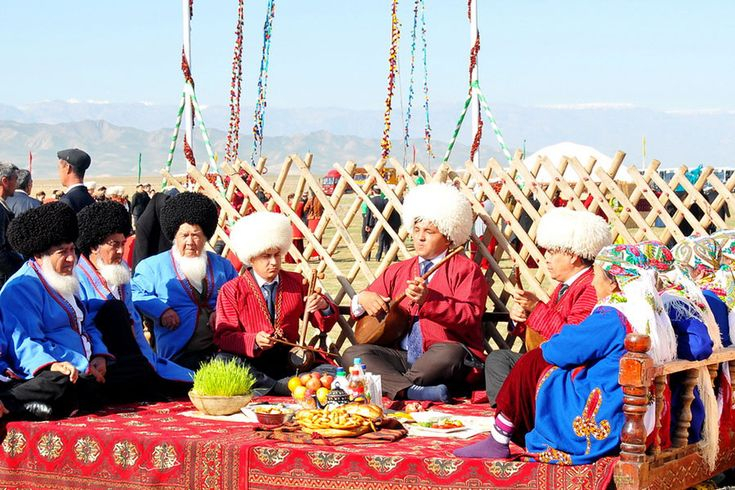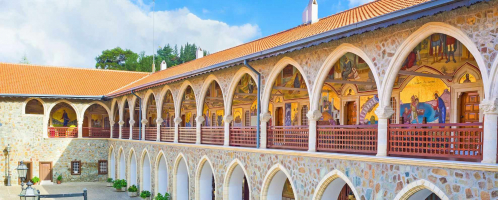Top 7 Turkmenistan Culture, Customs and Etiquette
The culture of Turkmenistan has an almost hypnotic appeal with raw and unmatched authenticity. Turkmenistan's unique traditions can now be appreciated on a ... read more...journey to this least-visited country in Central Asia, where tourists can ride a thoroughbred Akhal-Teke horse, hear the strum the wonders of gidjak, enjoy a traditional bakhshi performance, buy a Turkmen hijab and marvel at the centuries-old carpet-weaving process. Here is a list of Turkmenistan Culture, Customs and Etiquette that you should not miss.
-
The sparkling of Turkmenistan Culture & Traditions can be seen in the arts of Turkmenistan including the poetry and performances. As the chagatai language was used by Turkmen literature, the poetry of the great Turkmen poets of the 18th century was used this language.
Makhtum kuli, one of the greatest national poets of Turkmenistan was written the poetry which was very similar to Persian. The particular poet is in the form of Sufi philosophical treatises in poetic form. In the developed stages of Turkmen national poetry and its epic traditions, the contributions of Seitnazar Seyidi and Kurbandurdy Zelili were high. Due to annexation of Russian Empire on Central Asian countries, the influence of Sufism as well as Turkmen literature was faded away in the mid 19th century. The traditional dance performances especially in Turkmenistan Festivals were promoted by the state. The troupes of female dancers get rewards and fill the covers of magazines. They also travel to other countries as cultural ambassadors.
sitara.com 
sitara.com -
The development of Turkmen national costume is linked to climatic conditions, occupation, and historical ties. The traditional Turkmen costume was free and loose clothing that met all of the nomadic lifestyle's requirements. The man's costume was made up of a loose shirt, pants, and robe made of cotton fabric. The robe was made of striped silk fabric with red, white, and black stripes. Footwear consisted of shoes worn over woolen socks.
The host's status could be determined by his or her shoes. Rich people wore boots with white leather on the heel as well as boots with "kovush" galoshes. The headdress "telpek," which was made of black, white, and brown lamb, received the most attention, as it was a symbol of manhood. "Telpek" is a one-of-a-kind hat that keeps you cool in the summer and warm in the winter. It was also uncomfortable to wear "telpek" due to its large size, but in this case it was removed because there was a black head dress underneath it. Young horsemen typically wear white hats, while old men wear black or brown.
A straight shirt (dress), pants, a robe, and a headdress are also part of a woman's costume. It preserved the national uniqueness of folk costume. The dominant color in Turkmen women's clothing is red. The woman's shirt was made of red and crimson silk. "Chabyty" and "chekmeny" robes were made of dark blue, dark green, or red silk fabric with white or yellow stripes. Luxury embroidery was not the same as festive robes. A married woman's wardrobe consisted primarily of a robe "kurte" or "chyrpy" adorned with rich floral ornaments.

advantour.com 
pinterest.com/pin/731131320726492953/ -
Weddings in Turkmenistan, like in other Eastern countries, are not possible without national traditions and ceremonies. Wedding ceremonies became entwined with religious beliefs and ancient people's traditions. Today, traditions have lost their original meaning and become symbolic, while others have become relative. However, traditional aspects of weddings are still preserved. All costs directly related to marriage are borne by the groom's family, as is customary in the East. As a result, all relatives of the groom's family assist in wedding preparation.
The tradition of the obligatory ransom for the bride did not die. Furthermore, the groom's portion covers the wedding expenses. That is why, if the family has a son, the parents begin to save money while he is still a minor. A few words about the ransom; it is a fantastic opportunity for the girl's parents to improve their financial situation. But still a newborn boy is welcomed more than a girl, as the son stays with his parents after the age and marriage.
The dowry is delivered to the groom's home in Turkmenistan exactly nine days before the wedding. The dowry includes utensils, clothing, and carpets. The dowry was made by the bride herself many years before, many years before. When she ran out of time, her close relatives and friends came to her aid. They could weave and embroider everything needed for the yurt, as well as the entire outfit.
The wedding procession was once one of the highlights of the ceremony. The solemn event was lavishly decorated. The horse harness was adorned with jingling bells and shawls. Girls and women dressed in holiday attire rode the camels, which were adorned with magnificent carpets. Previously, camels served as the wedding convoy, but now cars make up the wedding motorcade. In Turkmenistan, special scarves are used to decorate cars instead of traditional balloons and ribbons.

yoair.com 
yoair.com -
These friendly people and old well-respected Turkmen traditions are distinguished by their hospitality. Turkmen frequently judge a person based on how he treats his guests. A visitor is greeted with the phrase "Khosh geldiniz!" and other ritual phrases such as: "How glad we are to see you! What an honor you've bestowed upon us! "are required.
The cloth with food on it is considered sacred, and stepping on it is a sin. Everyone should praise the Lord before eating, according to tradition. In the East, they say: "Every visitor has been sent by Allah!" It means that hospitality is both a duty and a sanctity for the host. This tradition originated in ancient times and has become ingrained in modern Turkmen culture. It was a simple form of security back then. People could not have survived the desert's hardships without the help of one another. As a result, if someone had been unfriendly to a traveler, even his relatives would have despised him. Turkmen have always revered bread and salt. Stepping on them was considered unlucky.

advantour.com 
advantour.com -
Turkmen carpets have long played an important role in Turkmen culture, having been woven out of a necessity arising from the harsh reality of daily life. Historically, nomadic tribes owned a variety of carpets, each of which served a specific purpose. Rugs for prayer, decorative rugs, carpets for family celebrations, and carpets that doubled as wardrobes and beds were all essential items for nomadic Turkmen. Carpets served as both decoration and insulation in traditional yurts during cold weather. They were used to divide a large room into separate quarters, slung across the backs of horses and camels, and spread out in open fields to make them feel more comfortable and familiar.
The Turkmen's transition to a sedentary lifestyle created the ideal conditions for the development of this ancient craft into an applied art. Carpet weaving skills were passed down from mother to daughter for generations, and in addition to following specific techniques, they were careful to select quality materials and dyes. Turkmen carpets were designed from the start to last for centuries.
The carpet is as much a Turkmen symbol as tulips are for Holland and cigars are for Cuba. According to one theory, goli (Turkmen rug patterns) originated with Oguz Khan, a legendary hero who is regarded as the Turkmen people's progenitor. According to some experts, the sun symbol is at the heart of the goli, as its inclusion in the Turkmen carpet began thousands of years ago, when sun worship was prevalent in the land.
turkmenportal.com 
alesouk.com -
Local folk dances are nothing short of colorful displays of Turkmen art, with each movement executed with precision to convey a specific meaning. Turkmen dances have absorbed many traditions over the centuries and now demonstrate the distinctiveness of this tribal culture. Kushtdepdi is a well-known and ancient Turkmen folk dance, as evidenced by a fresco discovered in Old Nisa depicting a group of dancers with movements reminiscent of kushtdepdi. The dance begins with the flowing movements of a girl and a boy who are surrounded by other clapping dancers.
During the dance, quatrains known as gazala are performed, each ending with exclamations of "uh-hu," "hey-ha," and "kusht-kusht." The rhythm is set by the dancers in the center, who are then echoed by those around them. Kushtdepdi is usually concluded with a loud cry of "huv-hak," after which the dancers come to a halt and place their palms to their faces. Kushtdepdi is performed in traditional crimson and burgundy costumes. Historically, kushtdepdi was only performed by the Turkmen Yomut tribes who lived on the Caspian Sea coast, and it wasn't until the end of the twentieth century that it spread throughout the country. It is now on the UNESCO List of Intangible Cultural Heritage and is almost exclusively performed at cultural festivals in Ashgabat and other cities.

commons.wikimedia.org 
advantour.com -
Bakhshi, itinerant musicians and storytellers who have been revered in Turkmenistan for centuries, are one of the most beloved embodiments of Turkmen folklore. Bakhshis were popular among many Turkic peoples during the historic medieval period, and they played an important role in preserving local epics and popularizing Turkmen classical literature. A bakhshi wore special clothing, including a don (thick cotton or wool robe), telpek (black or white wool hat), white shirt, soft leather boots, and wide trousers. Wherever they went, these orator-musicians drank from wells and ate with their own utensils, which they always carried with them. A bakhshi, on the other hand, would not travel alone, but would be accompanied by an assistant who was familiar with his mentor's habits and tastes.
Folk songs were once an important part of Turkmen culture, with separate songs for work and play. While many of these songs can still be heard today, the majority of them have lost their original meaning. For example, centuries ago, Turkmen worshiped a god named Suyt Gazan, who was thought to provide protection and rain. Although celebratory songs sung to Suyt Gazan still exist, they are now only played as children's melodies. Turkmen folk songs are mostly romantic in nature, with separate songs for men and women. Men's songs contain many figurative metaphors, comparisons, and epithets, whereas women's songs, known as lale, recount women's personal feelings and frequently speak of the difficulties of being female.
advantour.com 
advantour.com




























